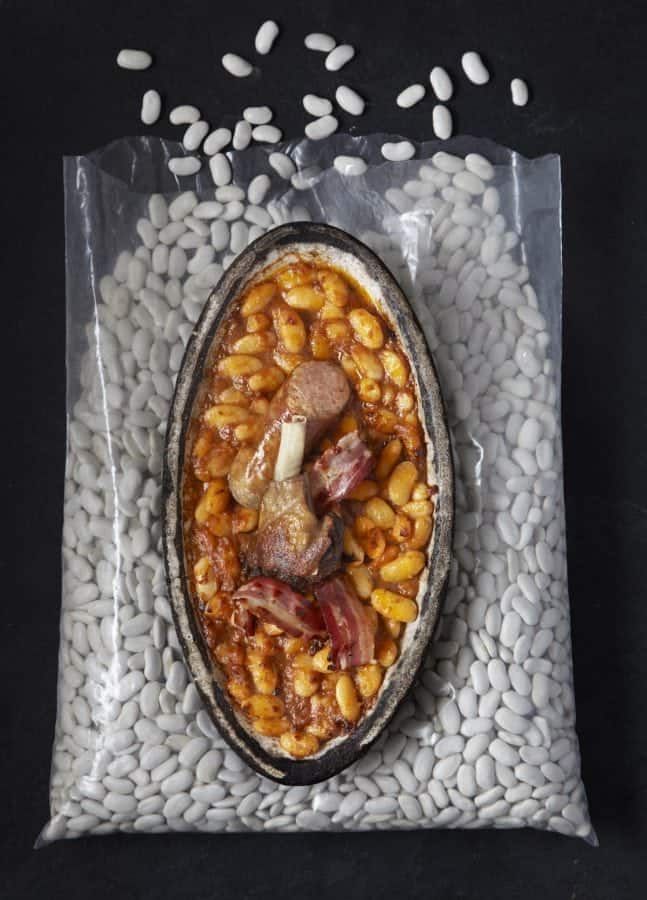
Fine dining is fine, but wholesome country cooking is the essence of French cuisine. Originating in the south of France, cassoulet is a quintessential Gallic dish, typically made with white beans, confit duck or goose and sausage. Michelin-starred Pascal Aussignac’s cassoulet follows the chef’s mother’s favourite recipe, comprising duck leg, Toulouse sausages and tarbais beans – larger than haricot beans with thinner skin.
In celebration of Bastille Day, Pascal Aussignac’s Comptoir Gascon will host a bottomless cassoulet party on Saturday 14th July, priced at £29 per person. Guests will receive free-flowing Ricard Pastis and Cassoulet Toulousain, served sharing style. Alternatively, the chef has shared the recipe for his Le Fameux Cassoulet.
“You may well know that there is not one ultimate cassoulet recipe but dozens, and each town in the South-west will claim theirs is the original. As I don’t want to stir up the hornet’s nest, I give you my mother’s own personal favourite, which does not have a crust of breadcrumbs (my family likes the cassoulet moist and saucy). One thing that you must bear in mind is always to cook a large cassoulet at least a day ahead, which enhances the flavour, then you can reheat it as required. It is the perfect party dish.”
“A true Gascon would choose the thin-skinned Tarbais beans for the ultimate cassoulet. They are grown around the village of Tarbes, and traditionally planted with corn so the pole acts as a prop for the vine to cling to as it grows. The vine and beans become entangled and so must be harvested by hand. The beans are bigger than haricots, and their main advantage is that when stewed for a long time, they retain their shape.”
600g dried Tarbais or Lingot beans, soaked overnight in cold water
2 onions, chopped
2 carrots, chopped
200g air-dried ham, e.g. Bayonne, chopped
200g pork fat (couenne) or unsmoked fatty bacon, chopped
1 ham bone, chopped into 3-4 chunks
1 litre duck or chicken stock, or water
Cloves from 1 head garlic, about 10, crushed
Sea salt and freshly ground black pepper
4 ripe tomatoes, finely chopped or crushed in a mouli
5 Toulouse sausages, halved
5 confit duck legs, halved
A little extra virgin olive oil or some duck fat, to serve
Drain the soaked beans and place in a large saucepan covered with water, bring to the boil, then simmer for about 5 minutes and drain.
In a large ovenproof saucepan (like a Le Creuset), sauté the chopped vegetables with the chopped ham and pork fat for about 10 minutes until softened. There is no need to add any oil or duck fat as the pork fat will render down.
Preheat the oven to 150 degrees Celsius/Gas 2.
Add the beans, ham bone pieces, stock (or water) and garlic to the vegetables and ham. Season lightly and bring to a gentle boil Then tip the crushed tomatoes on top, cover and place in the preheated oven for 1 hour.
Uncover after the hour and add the sausages and duck pieces, re-cover and return the cassoulet to the oven for another 30-60 minutes, or until the beans are tender. The dish should still be quite “juicy”. Remove the ham bones, pull off any tender meat and add to the cassoulet.
Ideally, cool the cassoulet and store in the fridge for at least a day, so that the flavours mature. Then reheat gently until hot and bubbling and mix in some olive oil or duck fat to enrich. If you really do like a crusty top, heat the cassoulet under a hot grill for a few minutes. If you need anything else (the cassoulet is filling!) a green salad would be good.
Comptoir Gascon’s Bastille Day party will kick off at 6pm on Saturday 14th July. Bookings can be made at comptoirgascon.com.
RELATED
https://www.thelondoneconomic.com/food-drink/make-pascal-aussignacs-crepes-de-simone/05/02/
https://www.thelondoneconomic.com/food-drink/restaurant-review-comptoir-gascon/19/06/
https://www.thelondoneconomic.com/food-drink/londons-best-french-restaurants/10/07/